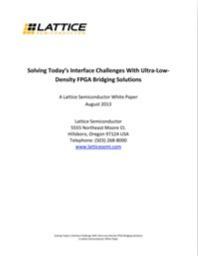Solving Today’s Interface Challenges With Ultra-LowDensity FPGA Bridging Solutions
Designers are implementing a wide variety of interface bridging solutions that allow them to transfer data across protocols and, in the process, expand system functionality. The challenge is determining how to most efficiently implement these new bridging solutions without violating system power, footprint and cost requirements.
This paper looks at potential solutions and examines how designers can tackle the interface challenge by implementing highly optimized bridging solutions in ultra-low density (ULD), low power field programmable gate arrays (FPGAs) that combine the flexibility of a programmable platform with high performance at low power.
Download to learn more.
Read More
By submitting this form you agree to Lattice Semiconductor Corporation contacting you with marketing-related emails or by telephone. You may unsubscribe at any time. Lattice Semiconductor Corporation web sites and communications are subject to their Privacy Notice.
By requesting this resource you agree to our terms of use. All data is protected by our Privacy Notice. If you have any further questions please email dataprotection@techpublishhub.com
Related Categories: Automotive, Communication, Embedded, Image sensors, Industrial, Microcontrollers, Power, Processors

More resources from Lattice Semiconductor Corporation
DESIGNING FOR LOW POWER
Power consumption is becoming an increasingly important variable when it comes to calculating OPEX and carbon footprint for telecom infrastructure ...
LEVERAGING FPGA AND CPLD DIGITAL LOGIC TO IMPLEMENT ANALOG TO DIGITAL CONVERTERS
An Analog to Digital Converter (ADC) is a common analog building block and almost always is needed when interfacing digital logic, like that in an ...
Implementing Flexible USB Type-C Control Using FPGA Technology
Type-C interfaces bring dramatic benefits to consumers. However, in order to realize this potential designers must implement Type-C's Power Deliver...
